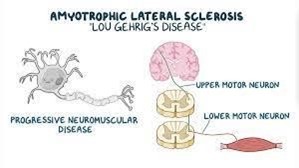A nurse is teaching a client who has amyotrophic lateral sclerosis (ALS) about the end stages of the disease process. Which of the following information should the nurse include in the teaching?
"You might wear splints over affected joints while you are sleeping."
"You will be given dexamethasone to treat muscle atrophy."
"You might require a machine to keep your airway open.
"You will receive nutrition through a central venous access device.
The Correct Answer is C
Choice A rationale:
Wearing splints over affected joints while sleeping is a strategy to prevent contractures, which are common in ALS.
Choice B rationale:
Dexamethasone is not used to treat muscle atrophy in ALS.
Choice C rationale:
As ALS progresses, clients may lose the ability to control their respiratory muscles, and a machine such as a ventilator may be required to assist with breathing.
Choice D rationale:
Nutrition through a central venous access device is not a standard intervention for ALS, as the focus is on preserving the client's ability to eat and swallow for as long as possible.

Nursing Test Bank
Naxlex Comprehensive Predictor Exams
Related Questions
Correct Answer is C
Explanation
Choice A rationale:
Exhibiting grief response behaviors may indicate the client is processing emotions related to the assault but may not necessarily indicate effectiveness of the plan of care.
Choice B rationale:
Stating a desire for revenge suggests unresolved anger and is not indicative of effective coping or progress.
Choice C rationale:
A sign of effectiveness in the plan of care for a client who has experienced sexual assault is the client's willingness to seek guidance and support in making important life decisions. This indicates a sense of trust in the nurse and a desire to move forward in a positive way.
Choice D rationale:
Demonstrating an increase in regressive behavior might indicate emotional distress but does not necessarily indicate effectiveness of the plan of care.
Correct Answer is B
Explanation
Choice A rationale:
Using a disposable adhesive probe when measuring the client's SaO2 is not an intervention that can reduce the exposure of the client to latex, because adhesive probes may contain latex and cause skin reactions. A better option would be to use a non-adhesive probe or a probe cover that is latex-free.
Choice B rationale:
Rationale: Latex sensitivity or allergy can lead to adverse reactions when exposed to latex- containing products, such as blood pressure cuffs. Wrapping the blood pressure cuff in a stockinette helps minimize direct contact between the cuff and the client's skin.
Choice C rationale:
Silicone products are usually considered safe for individuals with latex sensitivity because silicone is a different material. Silicone products are generally safe for clients who are sensitive to latex, unless they have a separate allergy to silicone.
Choice D rationale:
Cleaning vial stoppers for 15 seconds before using them to withdraw-medications for the client is not an intervention that can reduce the exposure of the client to latex, because vial stoppers may be made of latex or rubber and cleaning them does not remove the allergen. A better option would be to use vials that have latex-free stoppers or to avoid puncturing the stoppers with needles.
Whether you are a student looking to ace your exams or a practicing nurse seeking to enhance your expertise , our nursing education contents will empower you with the confidence and competence to make a difference in the lives of patients and become a respected leader in the healthcare field.
Visit Naxlex, invest in your future and unlock endless possibilities with our unparalleled nursing education contents today
Report Wrong Answer on the Current Question
Do you disagree with the answer? If yes, what is your expected answer? Explain.
Kindly be descriptive with the issue you are facing.
